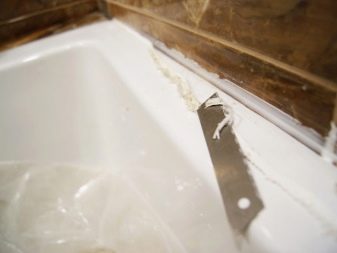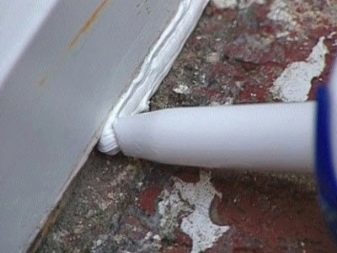How to quickly remove the old sealant in the bathroom?
Modern repair is difficult to imagine without the use of sealant for certain works. However, over time, the question arises of replacing the facing coating and removing the sealing compound from the surface. Our article will tell you how to quickly remove the old sealant in the bathroom.
Special features
In order to remove the old sealant in the bathroom, first of all you should pay attention to the surface on which it is applied. If it is enamel, then you need to work with it very carefully, so as not to damage the outer layer. Steel can be cleaned by various methods: it is a mechanical effect, and household chemicals, which do not affect the integrity of the coating. If the bathroom is laid tile, then it is also convenient to work with it, because it is resistant to chemical attack, but it is advisable not to scratch the outer layer, especially if it is glossy.
The process of removing sealant from acrylic surfaces is carried out carefully and with the help of properly selected compounds. Due to the popularity of acrylic baths, you can find a lot of tools on the market that you can use to wash them, put them in order, restore them, and carry out other activities with or near them.
Due to their special features, silicone and acrylic sealants are quickly and conveniently applied, and after they are completely dry, they become strong and resistant to moisture, light, temperature, and even chemical and mechanical effects. Because of these properties, it is difficult to remove the layer of matter that is unnecessary or spoiled by time and apply a new one. For an effective procedure, a number of techniques have been developed that make it easy to cope with this task.
Types of sealants
The use of sealants in the bathroom has become a real breakthrough in the repair and construction works, because with their help it is possible to reliably seal up small gaps and joints so that they cannot be seen, and the moisture cannot get to where it should not be. Most often, these products are used to seal the gaps between the back side of the sink and the wall, toilet and floor, shower stall and tiles on the floor and wall.
In addition, the sealant can be actively used for:
- greasing joints of water and sewer pipes, which increases the overall strength of the structure;
- eliminate the gap between the pan and the door in the shower;
- laying tile on a plasterboard wall, plywood, chipboard, metal or plastic (it is not recommended to use it on the floor due to heavy loads on it).
Due to the wide range of work that can be done with a sealant, the most suitable types of products have been developed for a specific application. Due to the presence in the composition of polymers, hardeners, fillers, dyes and a number of other components, it is possible to combine them in the right quantity and proportion so as to achieve an optimal result.
From what polymer is in the composition of the sealant, there are the following types of material that can be used in the bathroom:
- silicone;
- acrylic;
- polyurethane.
Silicone sealant is the most popular and at the same time the most expensive.
Its distinctive features are the following features:
- possibility of coupling with any materials;
- resistance to water, light and a wide range of temperatures;
- drying out, it practically does not shrink, the maximum percentage of shrinkage is no more than 2%;
- due to the elastic structure, it is possible to use for moving parts;
- has a large color range;
- possibility of use for internal repairs and outdoor;
- the process of hardening after application occurs in half an hour, and the final hardening takes 1-2 days.
Silicone sealant can be acidic and neutral. Acid variants have a peculiar smell similar to vinegar, and are not used for metal products, they are used for wood, glass, plastic and ceramics. The neutral option will cost more, but its scope of use includes all possible surfaces. This species has a special variety for the bath, the composition of which is supplemented with a fungicide that impedes the process of reproduction of parasites. Such a sealant is called sanitary and is used in the bathroom almost everywhere.
We should also talk about acrylic varieties of substances, which can also be used during repairs in the bathroom. This option is slightly inferior to silicone in price, but also serves not so long.
The main advantages of acrylic sealant are:
- ability to withstand temperature fluctuations;
- color fastness;
- high level of adhesion to various materials;
- it is possible to paint the sealant, varnish it or putty;
- the curing process takes one day.
The scope of use of acrylic sealant includes:
- filling voids on the surface of stone, brick or concrete;
- gluing the ceiling plinths in the room with the possibility of smoothing the irregularities of the walls;
- the possibility of grouting large enough.
The acrylic type is water-repellent and well suited for the bathroom.
Polyurethane sealant is used to seal joints on different surfaces: glass, wood, stone, concrete or ceramics.
The main features include the following points:
- high speed of hardening;
- possibility of use instead of glue;
- it is transparent, white, colored;
- very resistant and at the same time elastic composition;
- there is the possibility of painting the surface with paint or varnish.
A feature of this kind of sealants is an aggressive composition that causes skin irritation,because all work is carried out in protective gloves and suits.
Tools and tools for removal
In order to clean the bath from the old sealant or remove it from the tile, you need to know what tools and compositions for this can be used.
- For those surfaces that are not afraid of pressure and scratches, it is easier and more efficient to use a mechanical impact. It is most convenient to work with a conventional knife, but it is advisable to carry a flathead screwdriver and a simple razor blade with you. For the complete removal of the sealant from the surface it will be little to use the tools at hand, the most reliable option is to purchase a specialized knife or scraper for the sealant. There are manufacturers who produce such equipment with rubber nozzles on the sharp part, which makes it possible to neatly and quickly apply a new layer of sealant, while not acquiring additional tools.
- In cases where it is impossible to wipe off the sealant mechanically, you can use chemical agents. They actively influence the composition, helping to remove it mechanically more effectively.
If you need to remove the old layer of sealant quickly, and there is nothing suitable at hand, then you can use traditional tools to clean this material.
For more active penetration into the depth of the sealant, it is best to remove the top layer and apply the agent on the cut. Sealant is removed using a dry cloth after some time. If significant traces remain, then the procedure should be repeated twice until the surface is completely clean. In more detail about ways of removal of old sealant we will talk below.
How to delete?
In order to get rid of the old layer of sealant at home, you can use several techniques that are radically different from each other. If you need to clean the surface quickly, it is better to use a mechanical option. The principle of operation is to pry the edge of the sealant and remove it around the perimeter of the zone to be treated.
For work can be used as improvised means, and specially acquired. The mechanical version is suitable for removing sealant from tiles, steel, metal surfaces.It is not always necessary to remove the entire sealant during the repair process, sometimes it is necessary to remove only the top layer, which is updated to obtain an aesthetic effect and additional sealing of the object.
To carry out such an operation, it is best to work with a stationery knife, which must be very sharp in order to easily cut the frozen material.
The result of such work can be different: from a perfectly smooth surface to a strip with obvious irregularities. To remove the remnants of sealant that interfere with further work, you can take stationery gum and clean up the flaws with it. For a hard layer, it is worth trying pumice or sandpaper, after use, which you need to apply a new layer of sealant.
In cases where the mechanical removal of the sealing compound is impossible or impractical, it is better to refer to the use of chemical compounds. In this case, it is also worth being careful, because not all materials can withstand harsh chemicals. The principle of working with them is to dissolve the sealant, which can then be easily washed off from the right place.
Household solvents can be vinegar, acetone, white spirit, gasoline and salted water. It is recommended to use them in cases where the sealant has not yet stiffened and can be quickly removed.
If the solidification process has already ended, these funds will not help. The principle of operation of solvents of this type is to moisten the desired area well, allow the composition to absorb and wash off all the excess from the surface. Once the silicone has been removed, the treatment area must be washed well with a strong detergent.
If you have to work with the old and frozen layer of sealant, then you should buy specialized tools: "Penta 840", Dow Corning OS-2, which have a very aggressive composition, because the work process should be carried out with gloves, glasses and a respirator. Choose this option is needed for surfaces that do not lose color and other properties from exposure to chemicals.
If the package does not contain any reservations on use, it is worth checking the effect of the chosen agent on a small area where the sealant will be cleaned. If the reaction is not followed, then you can get to work.
If there are any changes in the color or structure of the surface, you should choose something else to wash the sealant in the bathroom.
Tips
- The process of applying sealant is not too complicated, but with insufficient experience, you can get not the highest quality result, which very soon will need to be redone. To avoid the need for repairs for a long time, it is important when applying a fresh layer to immediately remove all the smudges and use masking tape that will protect the surface from excess material.
- If the sealant is to be removed from the acrylic bath, then you can work only with specialized compositions for such products, all other options will spoil the appearance and surface layer, which after work will have to be further restored.
- If you need to remove the old layer of sealant and put a new one, then all work is carried out in gloves and with protection of respiratory organs and eyesight. If an aerosol or spray is used, it is important to use glasses so that the aggressive compound does not get into the eyes.
Before you put a new layer of sealant on the surface, it is worth testing it on a small area to be sure that there is no negative reaction to it.The correct choice of all components and high-quality work lead to a good result and a beautiful appearance of the bathroom.
How to remove the sealant or silicone from the enamel bath, see the following video.
















































